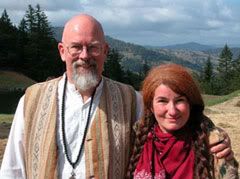On the surface, this posting is about our making a visa jump to Thailand but really it’s about much more than that. It’s about the power of love.
One of the restrictions that the Indian government places on tourists is that they can not stay in India longer than 180 days. If you want to stay in India longer than this, you need to leave India, even if only for one day, and then return, thereby enabling you to stay for another 180 days. This is called making a visa jump. When the time approaches for us all to make our visa jumps, Swami Kaleshawar sets aside a few weeks for everyone to travel to wherever they need to go. Most people at the ashram go to nearby countries, but some return home to see their families and friends. Swami is extremely careful to protect everyone at the ashram so certain countries, like Sri Lanka and Nepal, are off-limits due to political unrest. That leaves only a few other options; Singapore, Hong Kong and Thailand.
Tara and I were faced with a huge problem that we had no idea how to solve. In order to complete the University year, we’d have to make two visa jumps, each after 180 days, but we had no money to travel anywhere. Forget the second visa jump. We’d deal with that when the time came. First we had to figure out how to make the first one or else we’d have to leave India at the end of our first 180 days.
There had been a flurry of donations via PayPal to our India fund when we first announced it on our website. We arrived in India with enough money to last four months, maybe five if we were extremely frugal. We’d economized in every way possible, reducing our expenditures down to the bare necessities.

There’s a laundry service at the ashram that only costs 14 rupees (30 cents) per item but to save money we washed all our laundry in a plastic bucket in our bathroom. As the months passed, the donations coming in had dwindled to a trickle and now we were down to less than $100 with six more months of the university to go and two visa jumps required. It didn’t look good.
Swami was going to England, Germany and the United States to teach during the visa break and many of our friends at the ashram were planning on flying to California to attend the events in Joshua Tree and Santa Cruz. We still had our return tickets to America but, if we used them for our visa jump, it was extremely doubtful that we’d be able to afford new round-trip tickets to return to India to complete the second half of the University. Acyually using our return tickets to the States for one of our required visa jumps would have been a good idea because our return ticket expires after one year and that year is up a month before the university year ends. Needless to say, the final month of the university would be very important due to exams, Guru Purnima, and Swami’s conclusion to our training. We checked to see if we could pay more to extend the ticket but the airline said it wasn’t possible. Plus, even if we used it, we had no way to get back to India. What to do?
If we didn’t make a visa jump to somewhere nearby and inexpensive, we’d have to drop out of the University and not complete our training. We had absolutely no idea how we were going to solve this problem, so we placed it at the feet of the Divine and prayed. If we were meant to complete our year of training in soul healing then somehow a solution would be provided.
When the visa break began, our friends began to leave. Day by day, the ashram became quieter. After about a week, almost all the students had left, leaving only a few of us along with the Indian staff. The apartment building we live in seemed vacant. We enjoyed the silence and spent our days reading spiritual books that we’d been too busy to read during the routine of daily classes.
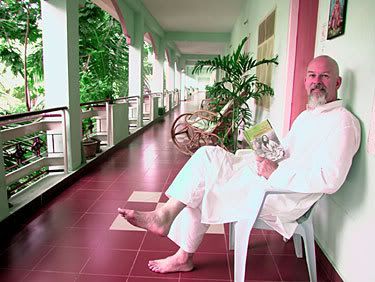
As the days passed, Tara and I wondered how we were going to be able to somehow make our visa jumps to the nearest and cheapest country to travel to. We kept checking airfares and decided that Thailand was our best bet. Hong Kong was out of the question. It was too far away and too expensive. Singapore, where most of our friends went, was also too expensive. One of the advantages of Singapore is excellent shopping, which is very attractive when you’ve been living in a remote rural Indian village, but we had no money for shopping and hotels in Singapore are more expensive. Thailand, on the other hand, was the cheapest to fly to and hotels there were much cheaper.
We knew, regardless of how it happened, that we had to make a visa jump so we made reservations for the very end of the visa jump period, hoping that we’d somehow be able to pay for the tickets when the deadline came. We kept checking our PayPal balance, hoping that some new donations had come in. Nothing arrived. As the days clicked by, it looked more and more doubtful that it was going to come together. We prepared for the worst by telling ourselves that if we had to drop out of the University, at least we’d been blessed to have six beautiful months learning profound spiritual knowledge that we’d carry with us forever. We tried not to think about what we’d miss if we had to leave without completing the University.
Tara and I had been in similar situations before. During the years we traveled with our Tibetan master, Dzogchen Khenpo Choga Rinpoche, we were frequently faced with apparently insurmountable obstacles. Serving as Khenpo Choga’s attendants and traveling with practically no money, while setting up hundreds of teaching events, was one of the most rewarding periods of our lives. The greatest gift that we received from this experience was that of gaining unshakable trust.
When you can’t eat because you only have enough money to buy gas to drive to the next town and you aren’t even sure about that, you can only rely on one thing. Trust.
Christ said,
“Take no heed for the body,
what ye shall eat,
what ye shall wear.
Bread, the men of the world seek after;
Seek ye the Kingdom of God,
And all these things will be added unto you.”
Throughout the years, Tara and I had discovered over and over again that when we were faced with a huge challenge, where no solution seemed possible, if we remained calm and trusted in the Divine, somehow what we needed was always provided. Khenpo Choga had told us that once you devote yourself to serving Buddha you will never go hungry. In all the time we served Khenpo Choga, we always had at least one meal a day. Now Tara and I saw our window of opportunity to make a visa jump slipping away. The day came when we had to pay for our tickets and we couldn’t pay for them so we lost those reservations. The prospects for making our visa jump and finishing the school year was looking pretty dismal. We began to think of packing up our belongings and making arrangements to return to the States.
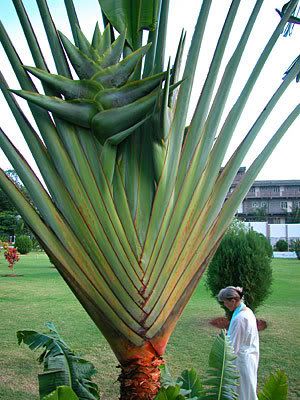
It was a poignant time. We were the last students left at the ashram. We realized how much we would miss the ashram that we’d grown to love so much. We’d miss the beautiful mountain, where in ancient times thousands of rishis meditated in secret caves, the gardens full of blooming tropical flowers and the Shirdi Sai Baba and Jesus temples. Most of all, we’d miss the new friends from around the world with whom we had been blessed to learn divine knowledge from a living saint. We thought of all these things, stayed calm and held firm in our trust in the Divine.
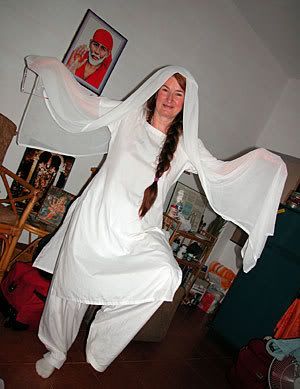
Just as we reached the final deadline for buying our tickets, our dear friends in New York who had purchased our round-trip tickets to India, emailed to say that they had deposited $600 in our PayPal account, just the amount we needed for two tickets to Bangkok. Tara jumped for joy. We thanked God not only for the solution but also for the challenge. We’ve found that times like this test our faith and that repeated tests over time build up our trust to the point where it is unshakable. We also thanked God for true friends who are there when you most need them. These friends who paid not only for our round-trip to tickets to India but also now for our tickets to Thailand are people who during my years of teaching Transcendental Meditation were my dearest, closest friends. They were my spiritual brother and sister and I’m the godfather of their son. It has been 23 years since I left the TM organization and a lot has happened since then. Life has changed in many ways and far too long has passed since I last saw these dear friends but the love that binds us on the deepest level hasn’t changed. In addition, to this validation of the eternal nature of love and true friendship, I received a donation of $200 for our visa jump from my 11th grade English teacher who I hadn’t seen or talked to in 40 years. That was another lesson to never doubt the power of love.
When Sri Kaleshwar came to California and performed a fire puja on a mountaintop in Malibu shortly before we came to India, he said that he’d noticed in his travels that few westerners have many really good friends. Tara and I know without a shadow of a doubt that we are in India only because of our friends and the blessings of the Divine. We thank God for their friendship and pray that we can fully utilize this wonderful opportunity to become pure channels of divine love in order to heal souls and help to alleviate suffering in the world. What we’re learning in India is that all healing is accomplished through love. God is love. We do not do the healing. Our job is to purify our self so that God’s love can flow through us. God’s grace is always available. We only need to open our hearts to receive it.
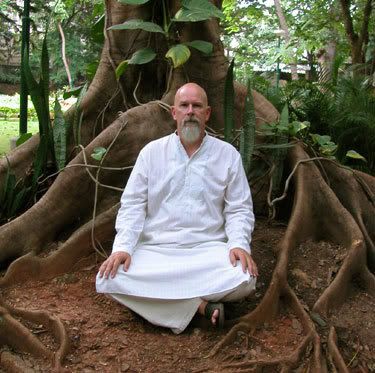
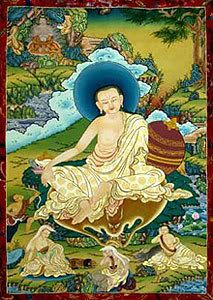 Milarepa, the most famous saint in Tibet, earlier in his life, was a black magician who was responsible for killing many people. After his family was murdered in a land dispute, Milarepa, in order to gain revenge, conjured up a hail storm to kill his enemies. Later, Milarepa became the disciple of Marpa, in the lineage of the Indian Siddhas Tilopa and Naropa, and attained enlightenment.
Milarepa, the most famous saint in Tibet, earlier in his life, was a black magician who was responsible for killing many people. After his family was murdered in a land dispute, Milarepa, in order to gain revenge, conjured up a hail storm to kill his enemies. Later, Milarepa became the disciple of Marpa, in the lineage of the Indian Siddhas Tilopa and Naropa, and attained enlightenment.
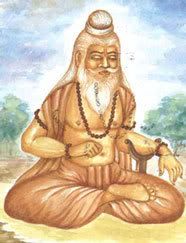 For thousands of years, India has been home to saints and sages who have plummed the inner depths of the soul and attained the heights of human consciousness. The spiritual history of India contained in the Vedas, the oldest known record of human experience on earth, contains a wealth of information regarding the mechanics of spiritual development. The Vedic rishis turned their attention within and through meditation discovered in the inner silence a vast storehouse of wisdom.
For thousands of years, India has been home to saints and sages who have plummed the inner depths of the soul and attained the heights of human consciousness. The spiritual history of India contained in the Vedas, the oldest known record of human experience on earth, contains a wealth of information regarding the mechanics of spiritual development. The Vedic rishis turned their attention within and through meditation discovered in the inner silence a vast storehouse of wisdom.  After being introduced to the spiritual teachings of the East by Madame Blavatsky and the Theosophical Society, Nicholas and Helena Roerich traveled for three years through India, Nepal, Tibet, China and Mongolia. During this time Nicholas painted thousands of paintings of the Himalayas, visited numerous temples and met with spiritual teachers. One of their major interests was the discovery the the spiritual kingdom of Shambala. The Roerichs founded the Urusvati Institute in the Kulu Valley, in the foothills of the Himalayas, in order to conduct research on Asian culture, herbs and spiritual traditions. They also founded the Agni Yoga Society to bring the messages of the Masters of the East to the world.
After being introduced to the spiritual teachings of the East by Madame Blavatsky and the Theosophical Society, Nicholas and Helena Roerich traveled for three years through India, Nepal, Tibet, China and Mongolia. During this time Nicholas painted thousands of paintings of the Himalayas, visited numerous temples and met with spiritual teachers. One of their major interests was the discovery the the spiritual kingdom of Shambala. The Roerichs founded the Urusvati Institute in the Kulu Valley, in the foothills of the Himalayas, in order to conduct research on Asian culture, herbs and spiritual traditions. They also founded the Agni Yoga Society to bring the messages of the Masters of the East to the world. 
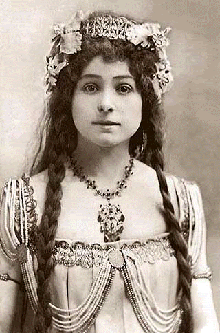 Alexandra David-Neel is one of the most interesting women in the history of the world. She was born on October 24, 1868. Her birth name was Louise Eugenie Alexandrine Marie David. By the age of 18, she was already expressing her strong urge for freedom and exploration and had already visited England, Switzerland and Spain on her own. A major turning point in her life, as well as the Roerich's, came when she began studying in Madame Blavatsky's Theosophical Society.
Alexandra David-Neel is one of the most interesting women in the history of the world. She was born on October 24, 1868. Her birth name was Louise Eugenie Alexandrine Marie David. By the age of 18, she was already expressing her strong urge for freedom and exploration and had already visited England, Switzerland and Spain on her own. A major turning point in her life, as well as the Roerich's, came when she began studying in Madame Blavatsky's Theosophical Society. Alexandra David-Néel wrote over 30 books about Eastern religion, philosophy, and her extraordinary travels. Probably her most famous trip was to the Tibetan capital of Llasa, which was forbidden to Europeans, during which she posed as a Tibetan man on pilgrimage.
Alexandra David-Néel wrote over 30 books about Eastern religion, philosophy, and her extraordinary travels. Probably her most famous trip was to the Tibetan capital of Llasa, which was forbidden to Europeans, during which she posed as a Tibetan man on pilgrimage.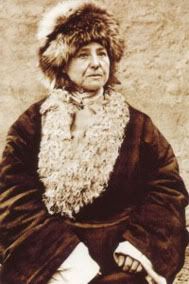 Alexandra also had the distinction of meeting the thirteenth Dalai Lama twice in 1912. During these meetings she had the opportunity to ask him many questions about Buddhism. While this does not seem so special today, when thousands of westerners have the opportunity to meet the Dalai lama, it was unprecedented for a European woman living then.
Alexandra also had the distinction of meeting the thirteenth Dalai Lama twice in 1912. During these meetings she had the opportunity to ask him many questions about Buddhism. While this does not seem so special today, when thousands of westerners have the opportunity to meet the Dalai lama, it was unprecedented for a European woman living then. Before the doorway to the East opened, the commonly accepted belief in western society was that Jesus Christ was the only Son of God and that humans, due to original sin, were fallen creatures. However, as westerners became aware of the rich spiritual heritage of Asia, they learned of an ancient tradition, stretching back thousands of years, in which God-realized saints demonstrated the same kinds of miracles that Jesus was reported to have performed.
Before the doorway to the East opened, the commonly accepted belief in western society was that Jesus Christ was the only Son of God and that humans, due to original sin, were fallen creatures. However, as westerners became aware of the rich spiritual heritage of Asia, they learned of an ancient tradition, stretching back thousands of years, in which God-realized saints demonstrated the same kinds of miracles that Jesus was reported to have performed. 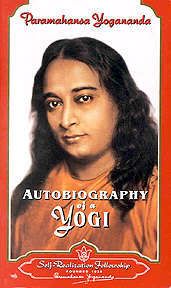 While western civilization has been familiar with the miracles that Christ performed, such as walking on water, turning water into wine and raising the dead, Indian history is rich with miracles that continue until today. A good introduction to this ancient miracle tradition can be found in “Autobiography of a Yogi,” by Paramahansa Yogananda and “Living With The Himalayan Masters,” by Swami Rama. Both of these highly accomplished yogis and God-realized masters recount vividly their meetings with advanced adepts and masters during their travels throughout India, Nepal and Tibet.
While western civilization has been familiar with the miracles that Christ performed, such as walking on water, turning water into wine and raising the dead, Indian history is rich with miracles that continue until today. A good introduction to this ancient miracle tradition can be found in “Autobiography of a Yogi,” by Paramahansa Yogananda and “Living With The Himalayan Masters,” by Swami Rama. Both of these highly accomplished yogis and God-realized masters recount vividly their meetings with advanced adepts and masters during their travels throughout India, Nepal and Tibet.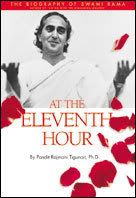 If you’re looking for a truly wonderful spiritual book, I highly recommend, “At the Eleventh Hour,” by Pandit Ragmani Tigunait, Swami Rama’s successor. This has become one of my all time favorite spiritual books. I’ve read it several times since arriving in India. It’s full of great stories about yogis, sadhus and avadhuts that Swami Rama knew and learned from during his many years in the Himalayas. Furthermore, it has special relevance regarding darshan of the Divine Mother.
If you’re looking for a truly wonderful spiritual book, I highly recommend, “At the Eleventh Hour,” by Pandit Ragmani Tigunait, Swami Rama’s successor. This has become one of my all time favorite spiritual books. I’ve read it several times since arriving in India. It’s full of great stories about yogis, sadhus and avadhuts that Swami Rama knew and learned from during his many years in the Himalayas. Furthermore, it has special relevance regarding darshan of the Divine Mother. Finally, we can’t speak highly enough about Paramahansa Yogananda’s wonderful “The Second Coming of Christ - The Resurrection of the Christ Within You.” This was the final book written by Yogananda before he left the body and he asked that it not be published until after the year 2000. Obviously, upon completing it, he felt that the world was not ready for the information that it contains but that after 2000 a change would have occurred. You will discover within “The Second Coming of Christ - The Resurrection of the Christ Within You” important information that is highly relevant to our spiritual development today.
Finally, we can’t speak highly enough about Paramahansa Yogananda’s wonderful “The Second Coming of Christ - The Resurrection of the Christ Within You.” This was the final book written by Yogananda before he left the body and he asked that it not be published until after the year 2000. Obviously, upon completing it, he felt that the world was not ready for the information that it contains but that after 2000 a change would have occurred. You will discover within “The Second Coming of Christ - The Resurrection of the Christ Within You” important information that is highly relevant to our spiritual development today.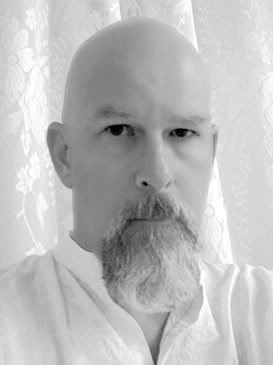
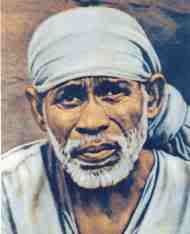 This is the short, very condensed version, of Shirdi Sai Baba’s life for those of you who may be unfamiliar with his life story. If you’d like to know more about the life of the greatest saint to have lived in India during the past several hundred years, see, “The Divine Mystery Fort, Vol. One,” which is available from Deva Publishing, or read the definitive biography of Shirdi Sai Baba’s life, the “Sri Sai Satcharitra.”
This is the short, very condensed version, of Shirdi Sai Baba’s life for those of you who may be unfamiliar with his life story. If you’d like to know more about the life of the greatest saint to have lived in India during the past several hundred years, see, “The Divine Mystery Fort, Vol. One,” which is available from Deva Publishing, or read the definitive biography of Shirdi Sai Baba’s life, the “Sri Sai Satcharitra.”
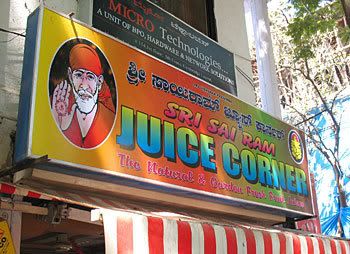
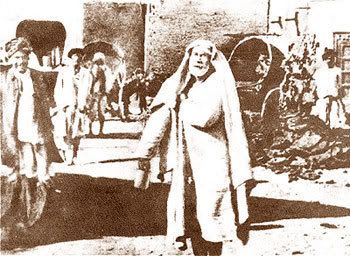
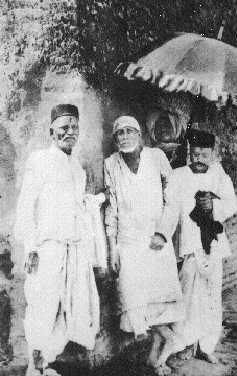 The town’s people’s attitude began to change when Baba started performing miracles, such as healing people and ridding the town of a cholera epidemic. Gradually his reputation spread and thousands of people began to come from around India to receive his darshan and blessing. But, even as his fame spread, Baba continued to live the simplest life. He lived in the ruins of an abandoned mosque, called the Dwarkama, with a broken roof that allowed the rain to pour in. He wore rags and continued to beg for food, mixing whatever he received in a bowl, feeding it to stray dogs and then eating whatever remained. He kept no money and gave the donations he received from devotees to the needy.
The town’s people’s attitude began to change when Baba started performing miracles, such as healing people and ridding the town of a cholera epidemic. Gradually his reputation spread and thousands of people began to come from around India to receive his darshan and blessing. But, even as his fame spread, Baba continued to live the simplest life. He lived in the ruins of an abandoned mosque, called the Dwarkama, with a broken roof that allowed the rain to pour in. He wore rags and continued to beg for food, mixing whatever he received in a bowl, feeding it to stray dogs and then eating whatever remained. He kept no money and gave the donations he received from devotees to the needy. 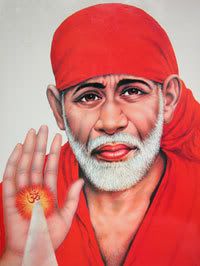 Shirdi Sai Baba's parting message was: “Try to see all religions as one. Whover has really surrendered their entire life to me. It is my responsibility to take care of them. Even from my samadhi, my bones will talk to them. I will send them the energy from my bones. Whover really comes to my samadhi, touches with an open heart, saying, “Please Baba help me,” my presence and my energy will be there to take care of them. Whoever has my picture in their home and chants “Om Sai Shri Sai Jay Jay Sai, they will receive my huge blessings and energy. From my samadhi I will talk to my students who really need my help. My bones will give an answer to them.”
Shirdi Sai Baba's parting message was: “Try to see all religions as one. Whover has really surrendered their entire life to me. It is my responsibility to take care of them. Even from my samadhi, my bones will talk to them. I will send them the energy from my bones. Whover really comes to my samadhi, touches with an open heart, saying, “Please Baba help me,” my presence and my energy will be there to take care of them. Whoever has my picture in their home and chants “Om Sai Shri Sai Jay Jay Sai, they will receive my huge blessings and energy. From my samadhi I will talk to my students who really need my help. My bones will give an answer to them.”
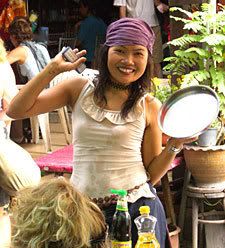 For us, probably our most memorable experience in Bangkok was dining at Mai Kaidee’s vegetarian restaurant. Seriously, we’ve come to the conclusion that Thai food is our number one favorite of all the food in the world. Thanks again to the Lonely Planet city guide to Bangkok, we discovered that Mai Kaidee’s was literally no more than a one-minute walk from our guesthouse. We slipped through an alley, crossed the street, ducked down another alley, turned the corner and there it was. Mai Kaidee’s has to be experienced to be believed. It’s not indoors. It’s an open-air restaurant in a narrow side street not much wider than an alley but the food is out of this world. Mai, a delightfully energetic and joyful Thai woman, has run the restaurant for years and offers cooking lessons as well.
For us, probably our most memorable experience in Bangkok was dining at Mai Kaidee’s vegetarian restaurant. Seriously, we’ve come to the conclusion that Thai food is our number one favorite of all the food in the world. Thanks again to the Lonely Planet city guide to Bangkok, we discovered that Mai Kaidee’s was literally no more than a one-minute walk from our guesthouse. We slipped through an alley, crossed the street, ducked down another alley, turned the corner and there it was. Mai Kaidee’s has to be experienced to be believed. It’s not indoors. It’s an open-air restaurant in a narrow side street not much wider than an alley but the food is out of this world. Mai, a delightfully energetic and joyful Thai woman, has run the restaurant for years and offers cooking lessons as well.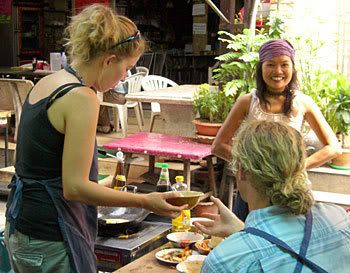
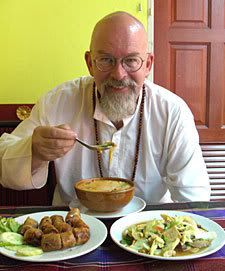 Tara and I found one of the few empty tables and started selecting dishes from the menu. When the food arrived, we’d never tasted Thai food this good. The more we ate, the better it tasted. The soup was the best I've ever tasted and the curries were out of this world. The better it tasted, the more we ate. I kept thinking that I wished all our friends back at home could taste this amazing Thai food.
Tara and I found one of the few empty tables and started selecting dishes from the menu. When the food arrived, we’d never tasted Thai food this good. The more we ate, the better it tasted. The soup was the best I've ever tasted and the curries were out of this world. The better it tasted, the more we ate. I kept thinking that I wished all our friends back at home could taste this amazing Thai food. 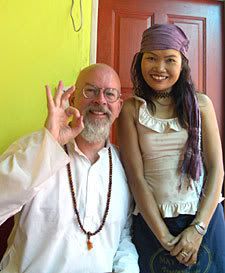 Finally, unable to eat any more, we started talking with Mai, who is incredibly joyful and exuberiant. She showed us her photo album that included photos of her trip to Moscow where she gave a taught a workshop in learning to cook Thai food at a top hotel. If you ever want to hire an incredible Thai cook to come give you private lessons, contact Mai. She’s a sweetheart and you’ll love her cooking.
Finally, unable to eat any more, we started talking with Mai, who is incredibly joyful and exuberiant. She showed us her photo album that included photos of her trip to Moscow where she gave a taught a workshop in learning to cook Thai food at a top hotel. If you ever want to hire an incredible Thai cook to come give you private lessons, contact Mai. She’s a sweetheart and you’ll love her cooking.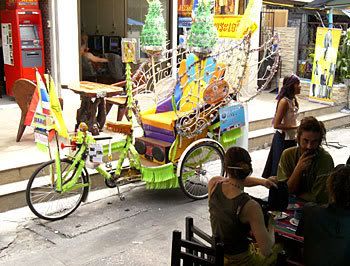
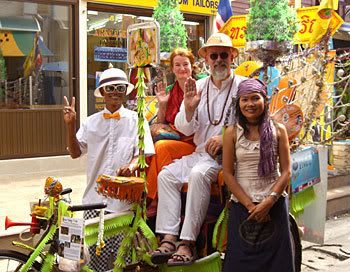


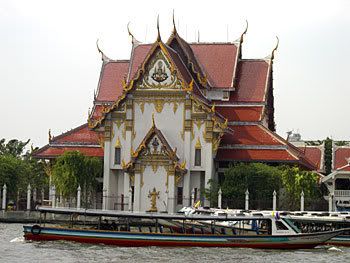
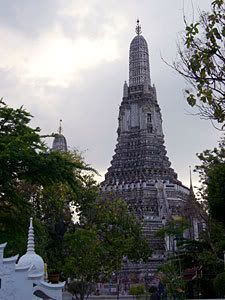 The Temple of the Dawn is an amazing place. From the river it looks like a huge missle launch pad. As soon as we arrived, we knew why we’d chosen this as the first temple we visited in Thailand. First of all, consider the name, the Temple of the Dawn. The name of our spiritual foundation is The Universal Fellowship of Light, and here we were appropriately at the Temple of the Dawn. The temple’s actual name is Wat Arun and it’s named after the Indian god of the Dawn, Aruna.
The Temple of the Dawn is an amazing place. From the river it looks like a huge missle launch pad. As soon as we arrived, we knew why we’d chosen this as the first temple we visited in Thailand. First of all, consider the name, the Temple of the Dawn. The name of our spiritual foundation is The Universal Fellowship of Light, and here we were appropriately at the Temple of the Dawn. The temple’s actual name is Wat Arun and it’s named after the Indian god of the Dawn, Aruna.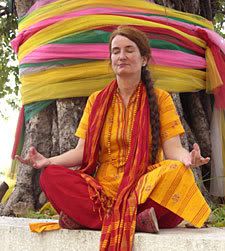 Entering the temple grounds, we first came to a very old banyan tree, wrapped with multi-colored cloth. We mediated under the tree, basking in the Inner Light. The main feature of the temple is an 82-meter tall spire that is decorated with colorful floral murals made of glazed porcelain. The temple is decorated with many beautiful statues and murals. Tara especially enjoyed the angels that surround the temple.
Entering the temple grounds, we first came to a very old banyan tree, wrapped with multi-colored cloth. We mediated under the tree, basking in the Inner Light. The main feature of the temple is an 82-meter tall spire that is decorated with colorful floral murals made of glazed porcelain. The temple is decorated with many beautiful statues and murals. Tara especially enjoyed the angels that surround the temple.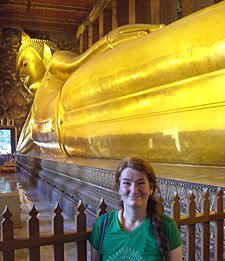 The Wat Pho grounds are really huge and the many buildings extremely beautiful but the main attraction is definitely the reclining Buddha that illustrates the Buddha’s passing into Nirvana. It is 46 meters long and 15 meters high.
The Wat Pho grounds are really huge and the many buildings extremely beautiful but the main attraction is definitely the reclining Buddha that illustrates the Buddha’s passing into Nirvana. It is 46 meters long and 15 meters high. Friends of ours, who used to live in Thailand, told us about the ultimate temple trip, but it was way beyond our budget. It’s a three-day boat trip on the nautical equivalent of the Orient Express train. You travel up the river from Bangkok on the Manohra 2, a boat that has been transformed into a luxury cabin cruiser, complete with antiques and Persian carpets. The boat docks overnight next to a temple and then continues the next day to the ancient city of Ayuthaya.
Friends of ours, who used to live in Thailand, told us about the ultimate temple trip, but it was way beyond our budget. It’s a three-day boat trip on the nautical equivalent of the Orient Express train. You travel up the river from Bangkok on the Manohra 2, a boat that has been transformed into a luxury cabin cruiser, complete with antiques and Persian carpets. The boat docks overnight next to a temple and then continues the next day to the ancient city of Ayuthaya.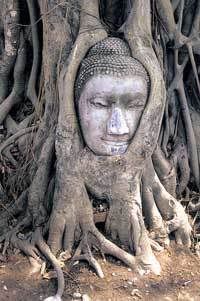 Ayuthaya is located at the confluence of three rivers and was the ancient capital of the Siamese Kingdom. It ruled the area for 400 years until the Burmese, using battle trained elephants, conquered the city in 1767. There are several museums in Ayuthaya, including the outstanding Chantharakasem National Museum. One of the most photographed sites in Thailand is also located in Ayuthaya, the famous Buddha head surrounded by tree roots that you’ve probably seen on postcards.
Ayuthaya is located at the confluence of three rivers and was the ancient capital of the Siamese Kingdom. It ruled the area for 400 years until the Burmese, using battle trained elephants, conquered the city in 1767. There are several museums in Ayuthaya, including the outstanding Chantharakasem National Museum. One of the most photographed sites in Thailand is also located in Ayuthaya, the famous Buddha head surrounded by tree roots that you’ve probably seen on postcards. 
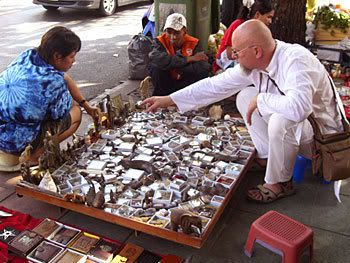
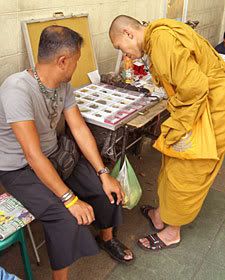 The street is full of amulet hunters. Many Buddhist monks are there as well, dressed in their saffron robes, They huddle around the vendor’s tables, inspecting the amulets with magnifying glasses.
The street is full of amulet hunters. Many Buddhist monks are there as well, dressed in their saffron robes, They huddle around the vendor’s tables, inspecting the amulets with magnifying glasses. 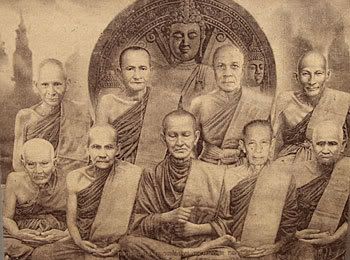
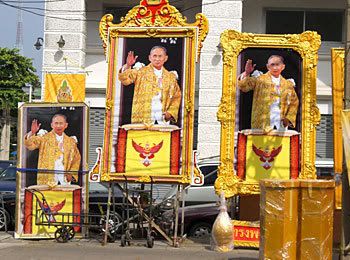
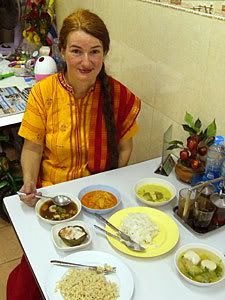 After about an hour of exploring, we arrived at our destination, a modest restaurant called Awawy. When I say modest, I mean really modest. You’d never go to Awawy for the décor, and ambience is not a word that comes to mind, but the Lonely Planet said that it was one of Bangkok’s best vegetarian restaurants and they were right. The food was delicious but that wasn’t what we’ll remember most about our experience there.
After about an hour of exploring, we arrived at our destination, a modest restaurant called Awawy. When I say modest, I mean really modest. You’d never go to Awawy for the décor, and ambience is not a word that comes to mind, but the Lonely Planet said that it was one of Bangkok’s best vegetarian restaurants and they were right. The food was delicious but that wasn’t what we’ll remember most about our experience there. 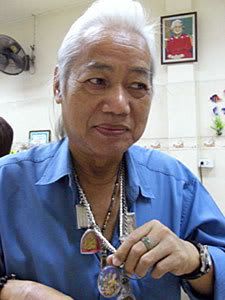 Half-way through feasting on several delectable dishes, that cost a total of $4 for the both of us, Tara noticed an interesting man enter the restaurant and sit at the table behind me. He was a striking older Thai man with a long white ponytail and a radiant face. Around his neck he wore many amulets, Buddhist medallions that are popular in Thailand. As we were about to finish our meal, I turned and said hello to the stranger. He smiled warmly, pointed to our clothes, and asked, “India?” We nodded in agreement. What then commenced was something that we had never experienced before. For the next hour we enjoyed a conversation with this stranger that consisted totally of mantras and the names of spiritual masters, gods and goddesses. It went something like this…
Half-way through feasting on several delectable dishes, that cost a total of $4 for the both of us, Tara noticed an interesting man enter the restaurant and sit at the table behind me. He was a striking older Thai man with a long white ponytail and a radiant face. Around his neck he wore many amulets, Buddhist medallions that are popular in Thailand. As we were about to finish our meal, I turned and said hello to the stranger. He smiled warmly, pointed to our clothes, and asked, “India?” We nodded in agreement. What then commenced was something that we had never experienced before. For the next hour we enjoyed a conversation with this stranger that consisted totally of mantras and the names of spiritual masters, gods and goddesses. It went something like this…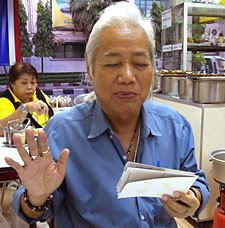 The conversation went on like this between people who shared no common language but the spiritual language of mantra and the names of divine souls. As we went back and forth, we felt a bond of recognition with this kindred spirit who we’ll probably never see again. We shared an awareness of spiritual realities and could tell by his familiarity with them that they were as important to him as they were to us. At the end of the conversation, we bowed to each other, smiled and went our separate ways. There was no need to exchange addresses. We knew where each of us lived.
The conversation went on like this between people who shared no common language but the spiritual language of mantra and the names of divine souls. As we went back and forth, we felt a bond of recognition with this kindred spirit who we’ll probably never see again. We shared an awareness of spiritual realities and could tell by his familiarity with them that they were as important to him as they were to us. At the end of the conversation, we bowed to each other, smiled and went our separate ways. There was no need to exchange addresses. We knew where each of us lived.
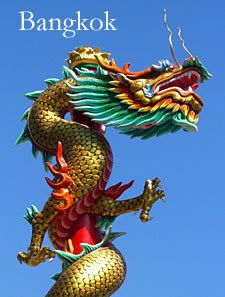 After receiving the money that we needed for our airplane tickets and some extra money for hotels, we booked the cheapest flight we could to Bangkok and made reservations for three nights at an inexpensive guesthouse in the Kho San Road area of Bangkok. Before we left the ashram, our friends who had gone to Thailand already had started to return, looking tanned and exhilarated from two weeks of lounging on beaches and scuba diving. Many of them warned us to stay only one night in Bangkok because of how over-crowded and polluted it was and recommended departing the next morning for the islands and beautiful beaches further south. Unfortunately, we couldn’t afford the added expense of traveling to a tropical island so we decided to stay in Bangkok and make the best of it. We weren’t really there for a vacation. Our purpose was to make our visa jump and we were grateful to even have a few days in Bangkok. Our friends had also warned us that it was hard to find vegetarian food since most of the Thai restaurants cook with meat. Before leaving for Thailand, I obtained a Lonely Planet Guide and discovered several highly recommended low cost vegetarian restaurants. More on that later.
After receiving the money that we needed for our airplane tickets and some extra money for hotels, we booked the cheapest flight we could to Bangkok and made reservations for three nights at an inexpensive guesthouse in the Kho San Road area of Bangkok. Before we left the ashram, our friends who had gone to Thailand already had started to return, looking tanned and exhilarated from two weeks of lounging on beaches and scuba diving. Many of them warned us to stay only one night in Bangkok because of how over-crowded and polluted it was and recommended departing the next morning for the islands and beautiful beaches further south. Unfortunately, we couldn’t afford the added expense of traveling to a tropical island so we decided to stay in Bangkok and make the best of it. We weren’t really there for a vacation. Our purpose was to make our visa jump and we were grateful to even have a few days in Bangkok. Our friends had also warned us that it was hard to find vegetarian food since most of the Thai restaurants cook with meat. Before leaving for Thailand, I obtained a Lonely Planet Guide and discovered several highly recommended low cost vegetarian restaurants. More on that later.
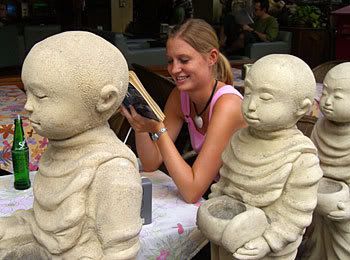

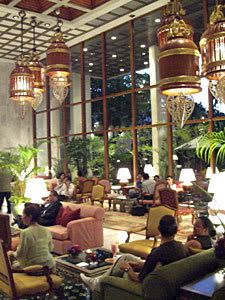 If someone was traveling to Bangkok and didn’t want to stay in a super inexpensive guesthouse like we did, I’d recommend staying at the 124-year-old Oriental Hotel. The Oriental is one of Bangkok’s most luxurious hotels and it’s also one of the most famous hotels in Asia. Located on the edge of the river, it was frequented by famous authors like Joseph Conrad, W. Somerset Maugham, John le Carre and James Michener. We didn’t stay there, although we would have loved to, but we did eat appetizers at the elegant riverside restaurant and it’s an experience not to miss. The Oriental operates another restaurant across the river so a ferry takes customers back and forth. A stay at the Oriental would be something you’d never forget.
If someone was traveling to Bangkok and didn’t want to stay in a super inexpensive guesthouse like we did, I’d recommend staying at the 124-year-old Oriental Hotel. The Oriental is one of Bangkok’s most luxurious hotels and it’s also one of the most famous hotels in Asia. Located on the edge of the river, it was frequented by famous authors like Joseph Conrad, W. Somerset Maugham, John le Carre and James Michener. We didn’t stay there, although we would have loved to, but we did eat appetizers at the elegant riverside restaurant and it’s an experience not to miss. The Oriental operates another restaurant across the river so a ferry takes customers back and forth. A stay at the Oriental would be something you’d never forget.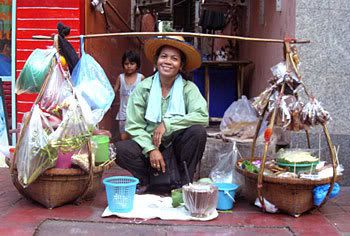
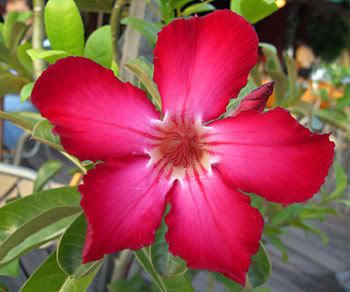
 There’s a laundry service at the ashram that only costs 14 rupees (30 cents) per item but to save money we washed all our laundry in a plastic bucket in our bathroom. As the months passed, the donations coming in had dwindled to a trickle and now we were down to less than $100 with six more months of the university to go and two visa jumps required. It didn’t look good.
There’s a laundry service at the ashram that only costs 14 rupees (30 cents) per item but to save money we washed all our laundry in a plastic bucket in our bathroom. As the months passed, the donations coming in had dwindled to a trickle and now we were down to less than $100 with six more months of the university to go and two visa jumps required. It didn’t look good.
 It was a poignant time. We were the last students left at the ashram. We realized how much we would miss the ashram that we’d grown to love so much. We’d miss the beautiful mountain, where in ancient times thousands of rishis meditated in secret caves, the gardens full of blooming tropical flowers and the Shirdi Sai Baba and Jesus temples. Most of all, we’d miss the new friends from around the world with whom we had been blessed to learn divine knowledge from a living saint. We thought of all these things, stayed calm and held firm in our trust in the Divine.
It was a poignant time. We were the last students left at the ashram. We realized how much we would miss the ashram that we’d grown to love so much. We’d miss the beautiful mountain, where in ancient times thousands of rishis meditated in secret caves, the gardens full of blooming tropical flowers and the Shirdi Sai Baba and Jesus temples. Most of all, we’d miss the new friends from around the world with whom we had been blessed to learn divine knowledge from a living saint. We thought of all these things, stayed calm and held firm in our trust in the Divine. Just as we reached the final deadline for buying our tickets, our dear friends in New York who had purchased our round-trip tickets to India, emailed to say that they had deposited $600 in our PayPal account, just the amount we needed for two tickets to Bangkok. Tara jumped for joy. We thanked God not only for the solution but also for the challenge. We’ve found that times like this test our faith and that repeated tests over time build up our trust to the point where it is unshakable. We also thanked God for true friends who are there when you most need them. These friends who paid not only for our round-trip to tickets to India but also now for our tickets to Thailand are people who during my years of teaching Transcendental Meditation were my dearest, closest friends. They were my spiritual brother and sister and I’m the godfather of their son. It has been 23 years since I left the TM organization and a lot has happened since then. Life has changed in many ways and far too long has passed since I last saw these dear friends but the love that binds us on the deepest level hasn’t changed. In addition, to this validation of the eternal nature of love and true friendship, I received a donation of $200 for our visa jump from my 11th grade English teacher who I hadn’t seen or talked to in 40 years. That was another lesson to never doubt the power of love.
Just as we reached the final deadline for buying our tickets, our dear friends in New York who had purchased our round-trip tickets to India, emailed to say that they had deposited $600 in our PayPal account, just the amount we needed for two tickets to Bangkok. Tara jumped for joy. We thanked God not only for the solution but also for the challenge. We’ve found that times like this test our faith and that repeated tests over time build up our trust to the point where it is unshakable. We also thanked God for true friends who are there when you most need them. These friends who paid not only for our round-trip to tickets to India but also now for our tickets to Thailand are people who during my years of teaching Transcendental Meditation were my dearest, closest friends. They were my spiritual brother and sister and I’m the godfather of their son. It has been 23 years since I left the TM organization and a lot has happened since then. Life has changed in many ways and far too long has passed since I last saw these dear friends but the love that binds us on the deepest level hasn’t changed. In addition, to this validation of the eternal nature of love and true friendship, I received a donation of $200 for our visa jump from my 11th grade English teacher who I hadn’t seen or talked to in 40 years. That was another lesson to never doubt the power of love.